
Hail Eris! floydanderson.com
Creepy the Inexcusable.
Of which the Goddess heartily approves.
Check out Creepy’s webpage at http://www.floydanderson.com.

Creepy the Inexcusable.
Of which the Goddess heartily approves.
Check out Creepy’s webpage at http://www.floydanderson.com.
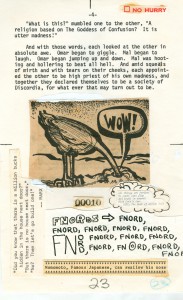
First up, a post meant for last week’s Illuminatus! Group Reading. Usually, we post an Eris of the Month entry every 23rd, but we’ll post that tomorrow on the 24th, just to give a little slap back to Our Lady of Confusion for her testiness.
I’m a little late to the fnord party, as this weird word was apparently first introduced into the Illuminatus! (Amazon) lexicon way back on page 280 and shows up here again in Week 30—just the same I thought I’d play a little catch up, although I really have no great fnord insights to share other than to point out the first known appearance of this weirdo word was in the 4th ed. of Principia Discordia.
To further illustrate Hill’s involvement—with RAW, Robert Shea and Illuminatus!—I post a letter here for your probable reading enjoyment from Hill to RAW in the year of our Goddess, 3141. This was during the period that Hill was living in NYC. Hill mentions a poster-collage he was contemplating / working on at this time that had “fizzled out,” although he later shared a rough version of it with RAW.
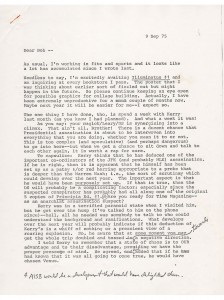
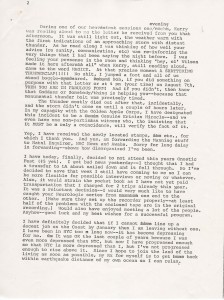
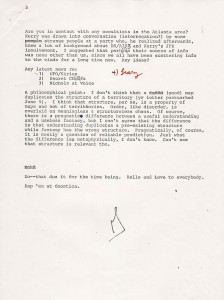

Courtesy of the Discordian Archives.

On page 2 of Hill’s letter, he recounts a synchronistic moment between he, Thornley and the spirit of RAW, which probably cemented even more in poor Kerry’s mind that RAW was an evil agent of the Illuminati who possessed paranormal powers and could deliver thunder bolts on request!
On page 3, Hill mentions another can of worms in Thornley’s head concerning a party in a Atlanta that is discussed in more depth in my latest book about all of this craziness, Caught in the Crossfire: Kerry Thornley, Lee Oswald and the Garrison Investigation (Amazon).
Towards the end, Hill inquires if there’s any news about Sirius, which of course was referring to RAW’s famous July 23rd encounter. The Secret Chiefs, I assume, also refers to the July 23rd Dog Days experience. Who “Nichols at Voice” was, I have no idea, unless it’s a reference to The Village Voice. As for Leary, he was still in prison at this point, but it was not long after—in April of ‘76—that California Governor Jerry “Moonbeam” Brown granted Leary’s release.
Hill finishes with a philosophical point—which is a bit over my head—although I think it’s referring to that quote by Alfred Korzybski of which RAW was so fond: “The map is not the territory.”
“Zap ‘em at Gnostica” refers—I believe—to a series of esoteric workshops that RAW was part of in San Francisco at this time sponsored by Gnostica magazine called Gnosticon. Here are some scans from the Gnosticon newsletter that includes RAW’s bio and a description of the workshops he presented, which consisted of his early explorations into Leary’s Eight Circuit Model of Consciousness.
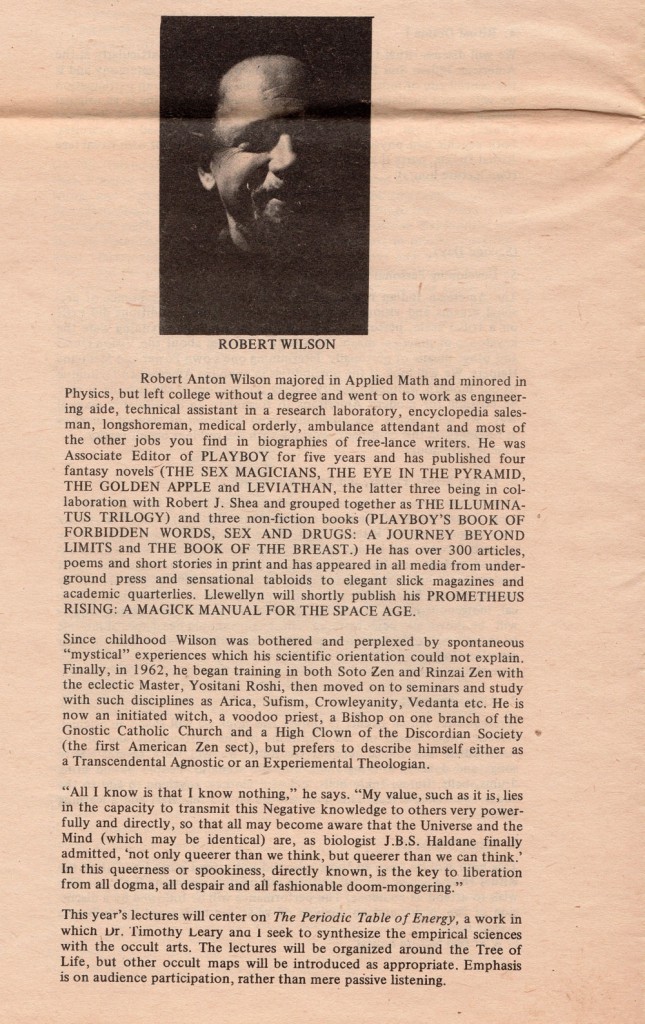
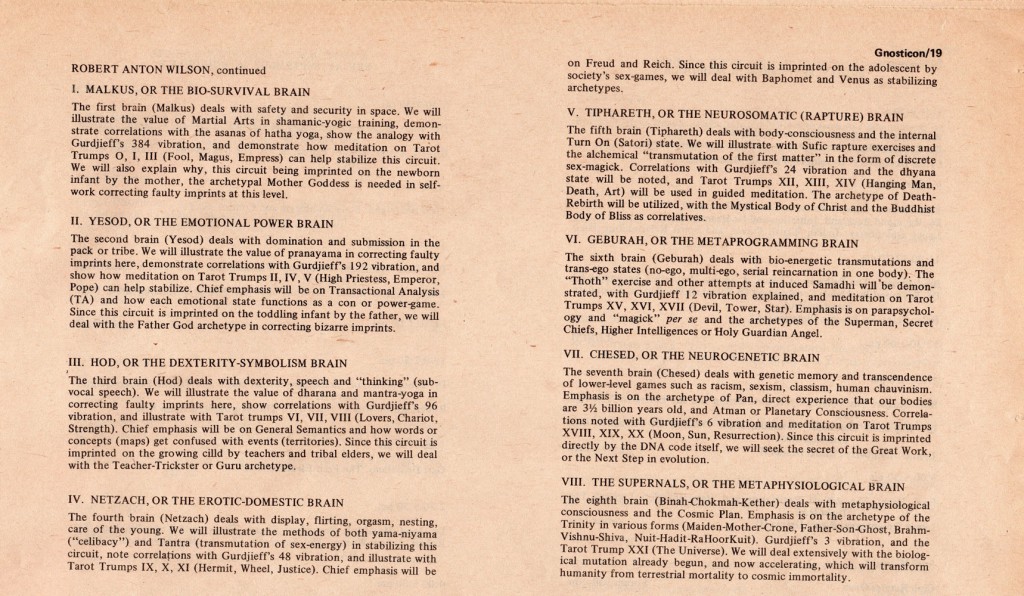
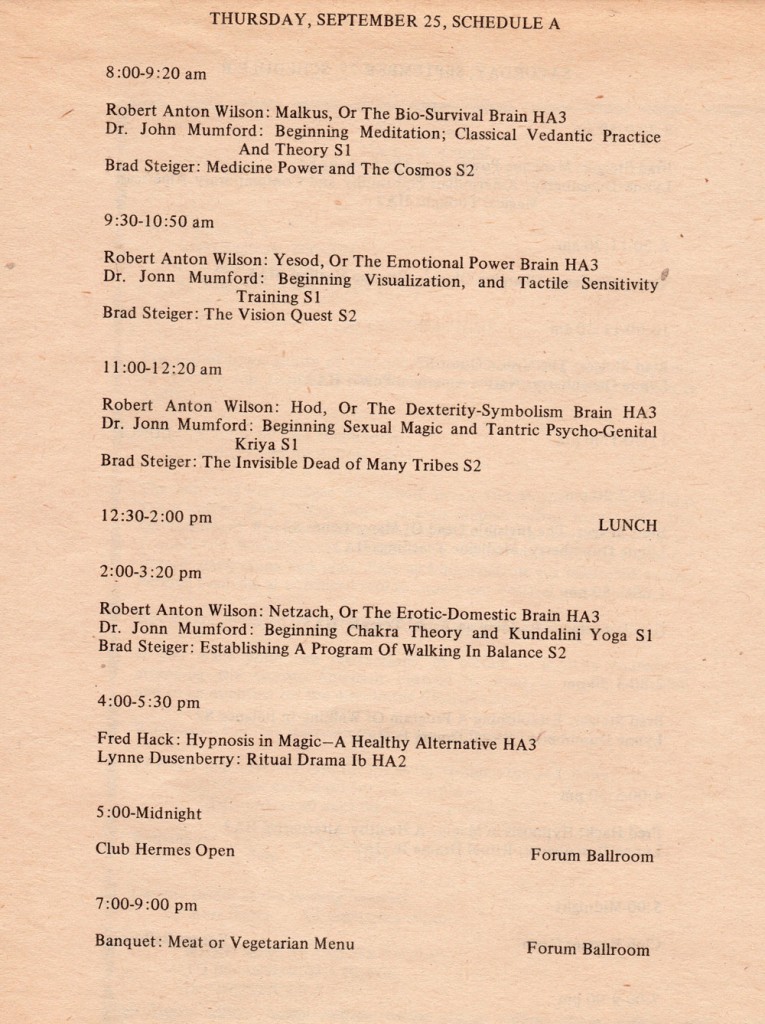
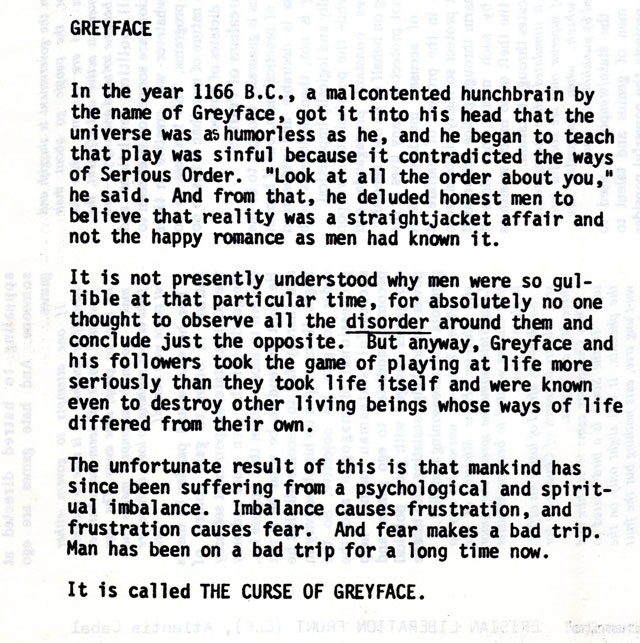
After reading this passage, Lady L., F.A.B. (aka Louise Lacey) remarked: “The problem in the world today is that the hunch-brains are united.”
Get in on the curse at RAWIllumination.net Illuminatus! Online Reading Group.

 Since launching historiadiscordia.com (on JFK Assassination Day last year) we’ve had—upon occasion—some rather eyebrow-raising visitors to the site, among them the Dept. of Justice, not to mention the Church of Scientology, and most recently the Dept. of Homeland Security (DHS) and the U.S. Department of Defense.
Since launching historiadiscordia.com (on JFK Assassination Day last year) we’ve had—upon occasion—some rather eyebrow-raising visitors to the site, among them the Dept. of Justice, not to mention the Church of Scientology, and most recently the Dept. of Homeland Security (DHS) and the U.S. Department of Defense.
We welcome you!
One can only speculate why THEY would be interested in little ol’ us, though I no doubt suspect that certain agencies in our gubmint have long been trying to get a handle on just exactly what Discordianism “is” and to determine if it’s a threat to National Security. (Why anyone would fear a religion based on the worship of the Greek Goddess of Chaos and Discord is beyond me!)
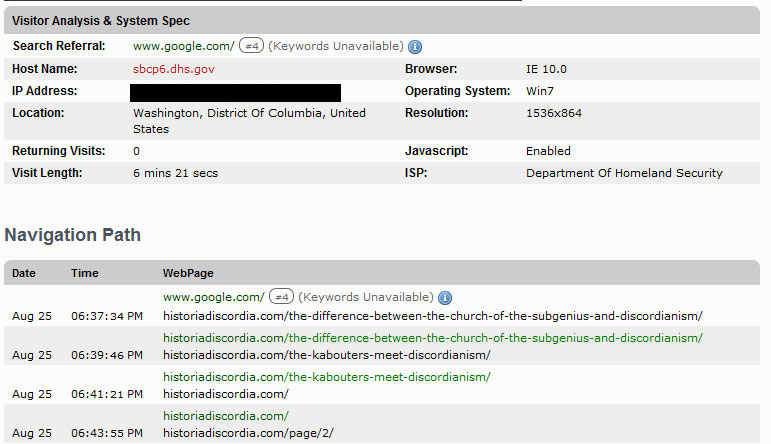

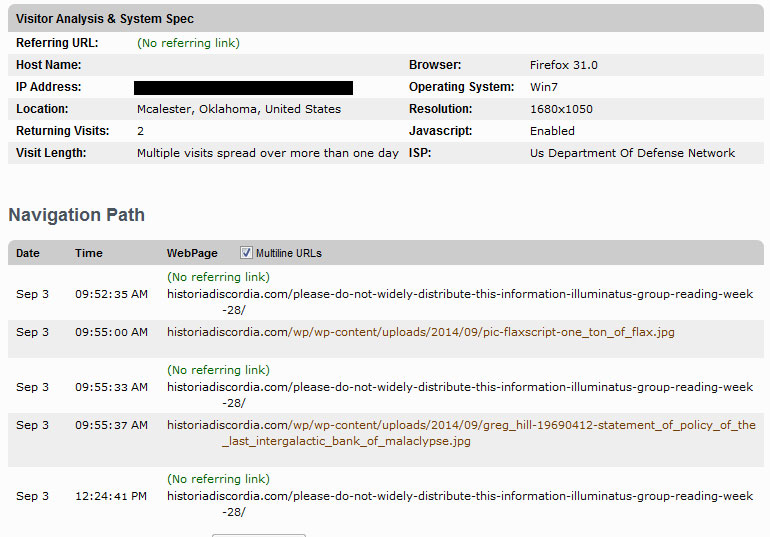
As seen in the assembled screen shots—which were captured during a couple of the DHS and DOD visits—at one point THEY hit the Illuminati tag, a Discordian connection that dates back to the glory days of Operation Mindfuck (OM) when Kerry Thornley—in cahoots with his other Discordian miscreants—cooked up the modern day Bavarian Illuminati (The World’s Oldest And Most Successful Conspiracy).
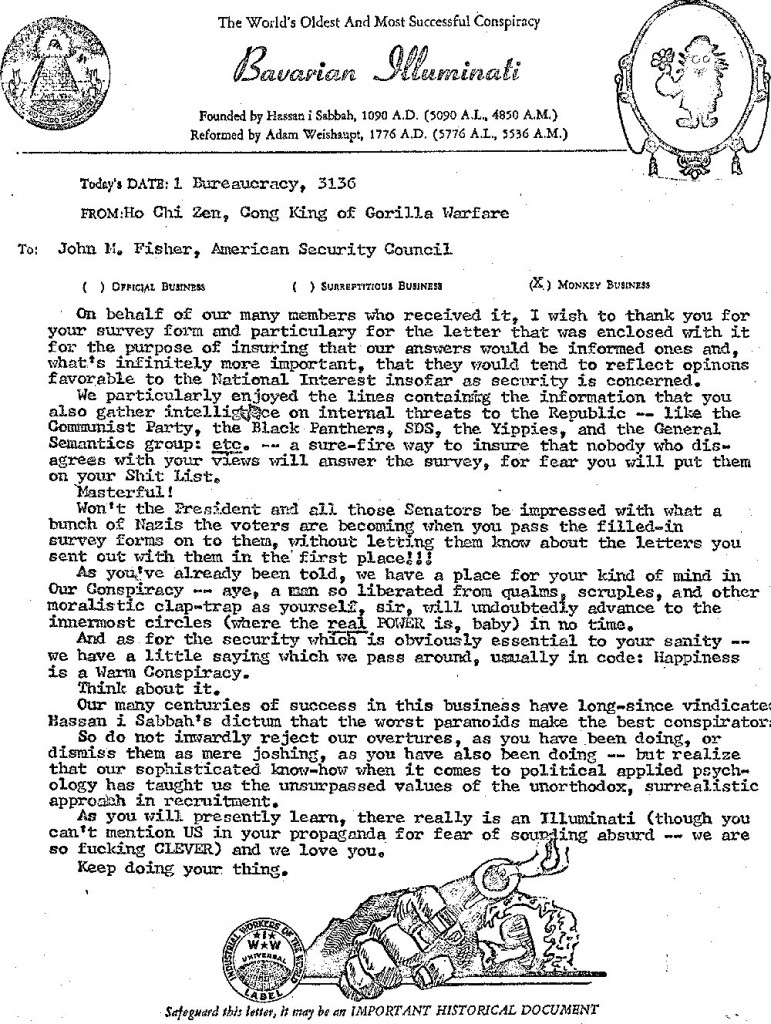
Discordianism—as Erisian history instructs—has enjoyed a long association with the Illuminati (which may secretly run the U.S. Government!) as well as certain other Governmental branches (because we all know where “true” chaos comes from!) among them the military, and in particular the Pentagon which is incorporated into the Sacred Chao, that most holiest of all Discordianism symbols.
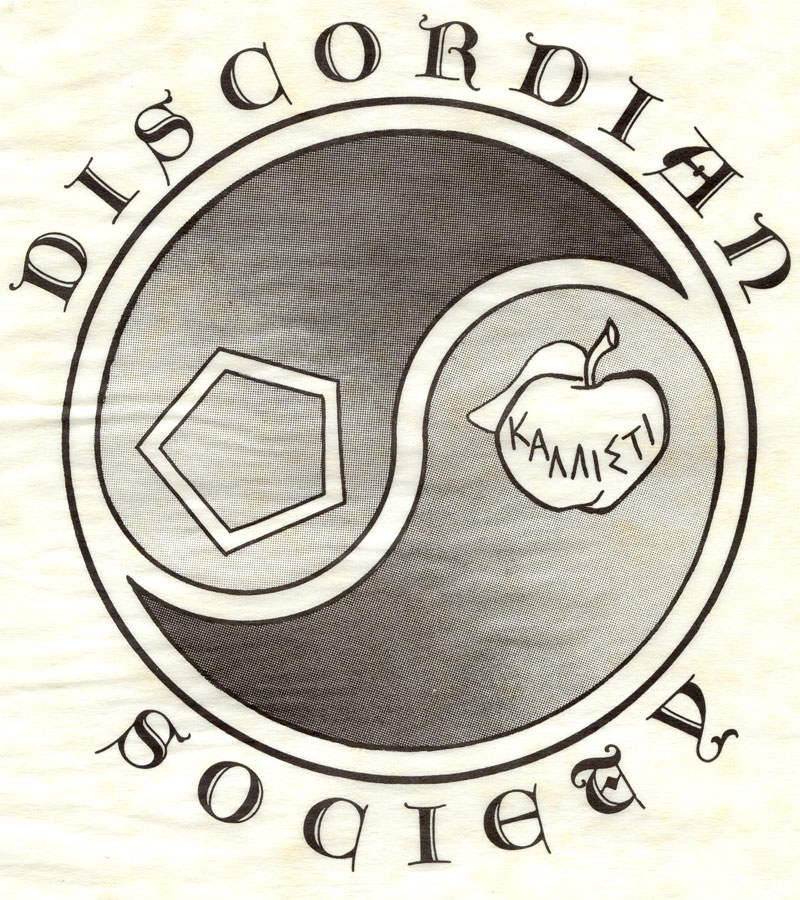
The Sacred Chao is a twist of sorts on Taoism’s Yin and Yang, depicting as it does the opposing forces of The Pentagon and The Golden Apple, also known in Discordianism as the Hodge and Podge. The Pentagon—according to Discordian mythos—represents the Aneristic Principle (Apparent Order) in counterbalance to The Golden Apple, which represents The Eristic Principle (Apparent Disorder.) To find out more about all this you will have to consult your pineal gland and call me when the brain swelling goes down.
The 1st edition Principia Discordia lists several Orders of Eris, one of which is the Knights of the Five Sided Temple, “a movement that is specifically Anti-Discordian. Such people are almost invariably found to be either bureaucrats or militarists (frequently both). The Five Sided Temple referred to is The Pentagon Bldg. itself where there is an incredible concentration of Knights. In your own experiences with military service and bureaucracies, you will notice many people with a heavy tendency towards the Eristesque Principle, but every so once in awhile you will find a person who is absolutely wound up in all sorts of fantastic and technical formal order which due to its own weight ends up only in a comical-absurd cross-reference maze of nothing; and such a person who lives, thinks and breathes in such terms—he is a Knight.”

As you can see, Discordianism has long been connected to the Pentagon, which some may also find confusing, because many people considered those old school Discordians just a bunch of long haired pot smoking no-good hippie types—which of course many of them were!—so the Discordian Society’s apparent veneration the Five Sided Temple might appear a bit perplexing to some. However, all of these five-sided Discordian endeavors were simply a means to demonstrate the dichotomy found in Discordianism—the Aneristic vs. Eristic principles—which is not unlike the ol’ good vs. evil dualism of Christianity, because without one you couldn’t have the other. (Maybe.)
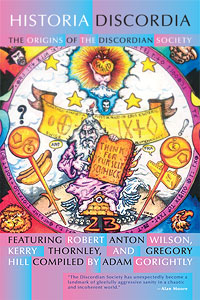 If you’d like to find out more about the hidden history of Discordianism, Illuminism and its sinister connections to not only the U.S. Government, but all governments of the world, I would encourage you (and THEM) to pick up a copy of Historia Discordia: The Origins of the Discordian Society while copies last!
If you’d like to find out more about the hidden history of Discordianism, Illuminism and its sinister connections to not only the U.S. Government, but all governments of the world, I would encourage you (and THEM) to pick up a copy of Historia Discordia: The Origins of the Discordian Society while copies last!
No government office should be without one!
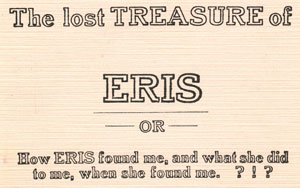 We recently posted some scans from a little Discordian ditty called the Lost Treasure of Eris.
We recently posted some scans from a little Discordian ditty called the Lost Treasure of Eris.
The fellow who sent the scans, Alfred Vitale, was pleased as punch about this, and sent me a few more snapshots of this Erisian wonder, along with these comments:
LOVED the piece on your blog! Finally started Historia Discordia… it is awesome! I will write more in detail at some point soon… it makes me laugh out loud. Nobody in my house knows what Discordianism is… but I’ve tried to share Principia and whatever doctrinal witticisms I could, but they just rolled their eyes. Same thing happened when I gave a talk recently at a high school. 15 kids in the room, but ONE of them decided to go check out Principia online… perhaps a seed planted. But I think your book has made my wife and daughter believe that my lunacy is not so unique now… so thanks 🙂
I had to use my camera phone because the book’s a bit fragile and if I lay it flat it may fall apart. These are a couple of random page shots—not complete pages, but maybe helpful?

page on the books publication.
Courtesy of Alfred Vitale.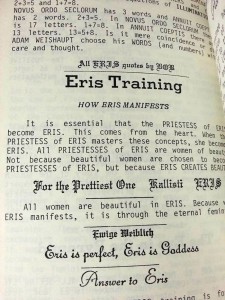
Eris Training.
Courtesy of Alfred Vitale.
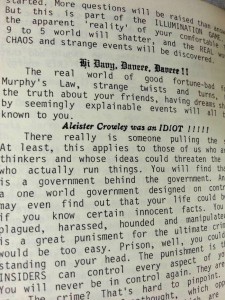
page on Aleister Crowley.
Courtesy of Alfred Vitale.
The Book of Gammy Grogs.
Courtesy of Alfred Vitale.
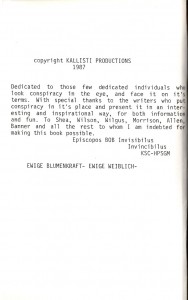


The Lost Treasure of Eris also happens to be dedicated to a number of Bobs—including the aforementioned Wilson and Shea—not to mention a certain someone named Banner. In this case, I assume Episcopos BOB was referring to Bob Banner, former editor and publisher of the late, great conspiracy magazine Critique that during the course of its run would occasionally feature articles by RAW.

Courtesy of the Discordian Archives.
The Lost Treasure of Eris dedication page also acknowledges Neil Wilgus, author of The Illuminoids, another must-have book for one’s Illuminati Discordian-library back in the day when the Eye in the Pyramid had suddenly become all the rage.

So it appears that the Magickal Childe had an affinity for Discordian obscurities such as these.
Alfred and I would like to track down the origins of this strange relic—The Lost Treasure of Eris—that was supposedly first published 10 years or so before its ’87 re-publication. So if you have any info please let us know!
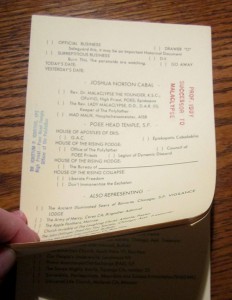
Due to this Dilbert-like influence, Greg created a form letter of sorts modeled after inter-office memos one would see in corporate offices of the period.
The memo in question was produced some time after the mysterious disappearance of Malaclypse the Younger when Hill adopted the persona of Dr. Ignotum P. Ignotius to oversee the Office of the Polyfather.
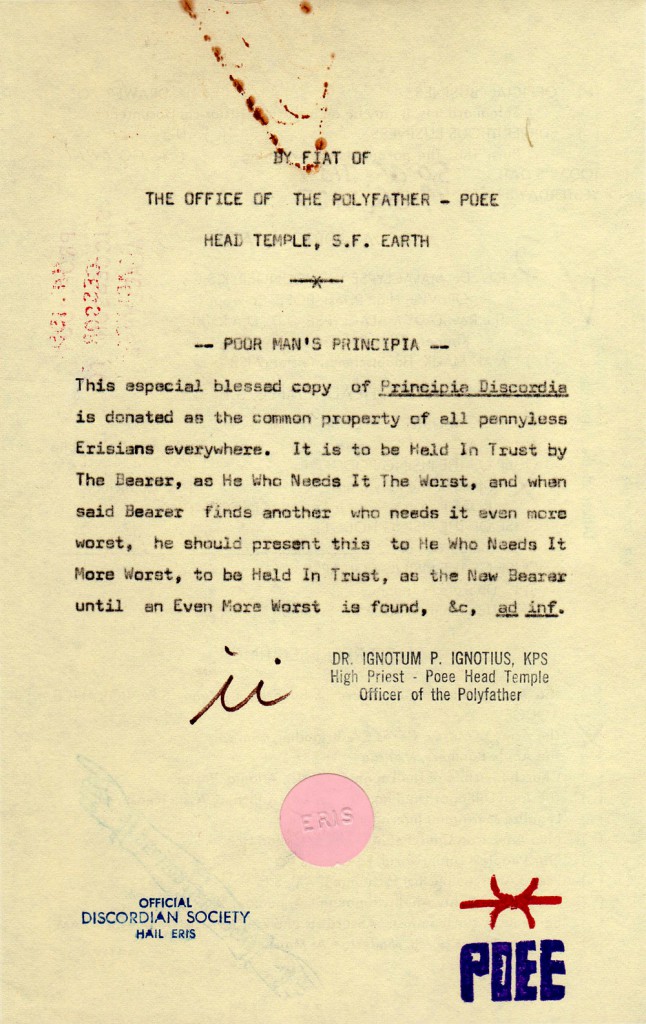
by Greg Hill dated July 15, 1971, Back.
Courtesy of the Discordian Archives.
by Greg Hill dated July 15, 1971, Front.
Courtesy of the Discordian Archives.

Known in the annals of Discordianity as Rev. Hypocrates Magoun (Protector of the Pineal), Newport was high school pals with Greg Hill and Kerry Thornley back in the days of Bowling Alleys, Eris, and a Revelation with a Baboon. Newport contributed to the 4th edition of the Principia Discordia with “The Parable of the Bitter Tea,” which of course has a deeper meaning than you can read on the surface—although I’m not quite sure what that is—so I’ll leave it to Brenton Clutterbuck to reveal this deeper mystery in his forthcoming book, Chasing Eris.
After Greg Hill’s passing, the Discordian Archives ended up in Newport’s keeping, and he had planned to put these materials on a website but never quite found the time as he had become more interested in landscape painting. And so perhaps he got the best of both worlds, as HistoriaDiscordia.com (maybe) became what he was envisioning, and in the meantime, Newport was able to follow his painting passion and not have to dicker around with HTML and all that nonsense. More on current happenings of Dr. Robert in a bit…
Here’s some more on Dr. Robert Newport and Greg Hill, lifted (mostly) from my previous book The Prankster and Conspiracy:
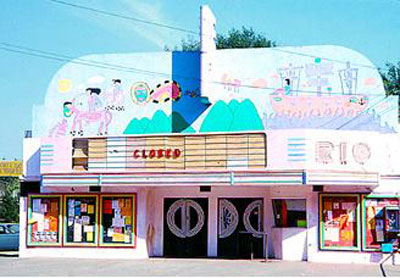
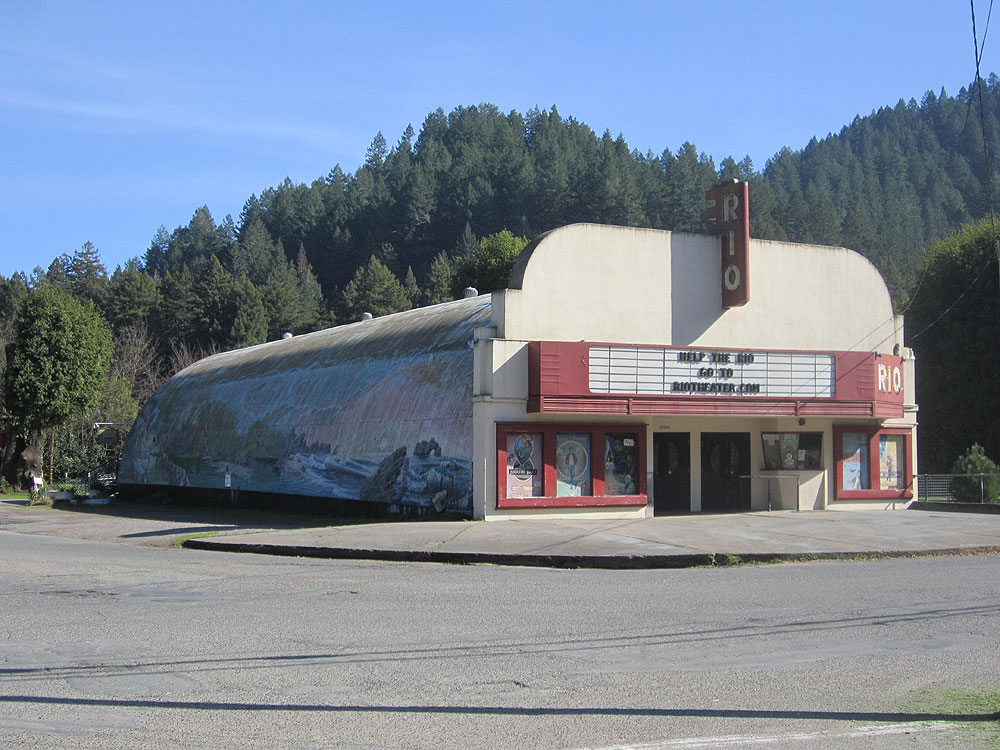
Courtesy of the Discordian Archives.
Housed in an old converted military Quonset hut, Cinema Rio had five hundred seats, as well as a vast population of rats until a twenty-two pound Siamese cat named Eldritch became a Cinema Rio regular. “And,” as Newport recalled, “that was the last of the rats, the night Eldritch walked into the theater. We brought him in, put him down in the lobby, his ears went up, and he was gone like a flash—and from that night on there were no rats!”


Cinema Rio was unique in the sense that it was a community effort, a theater by and for the local residents. In this spirit, local artists were enlisted to help decorate the digs, which included a beautiful colored marquee outside, displaying a cartoonish Mayan motif. The inside of the theater was originally a dull pink, so—to give it some pizzazz—columns and figures, swirling and twirling about, were painted on the walls, giving the place the funky feel of an old-time theater reborn with a psychedelic sensibility.
Greg and Bob ran Cinema Rio on a shoestring, with Greg putting the programming together, in addition to designing the posters and advertisement blurbs. As part of their community outreach, once-a-month programming meetings were held where the locals could contribute suggestions for films. Thus a concerted effort was made to involve the community, which meant employing it, as well. In fact, Greg and Bob ended up employing way too many locals to ever turn a profit.
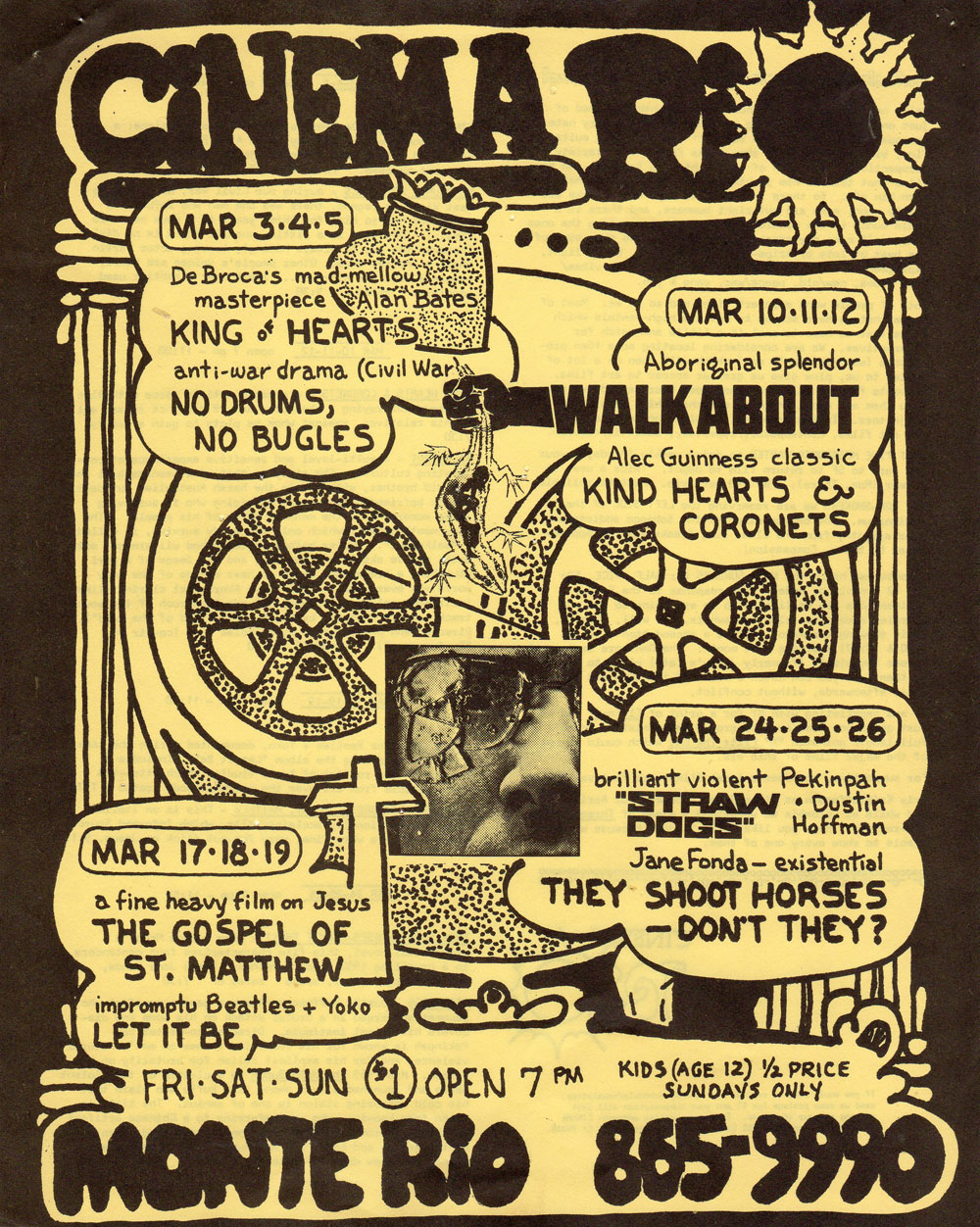
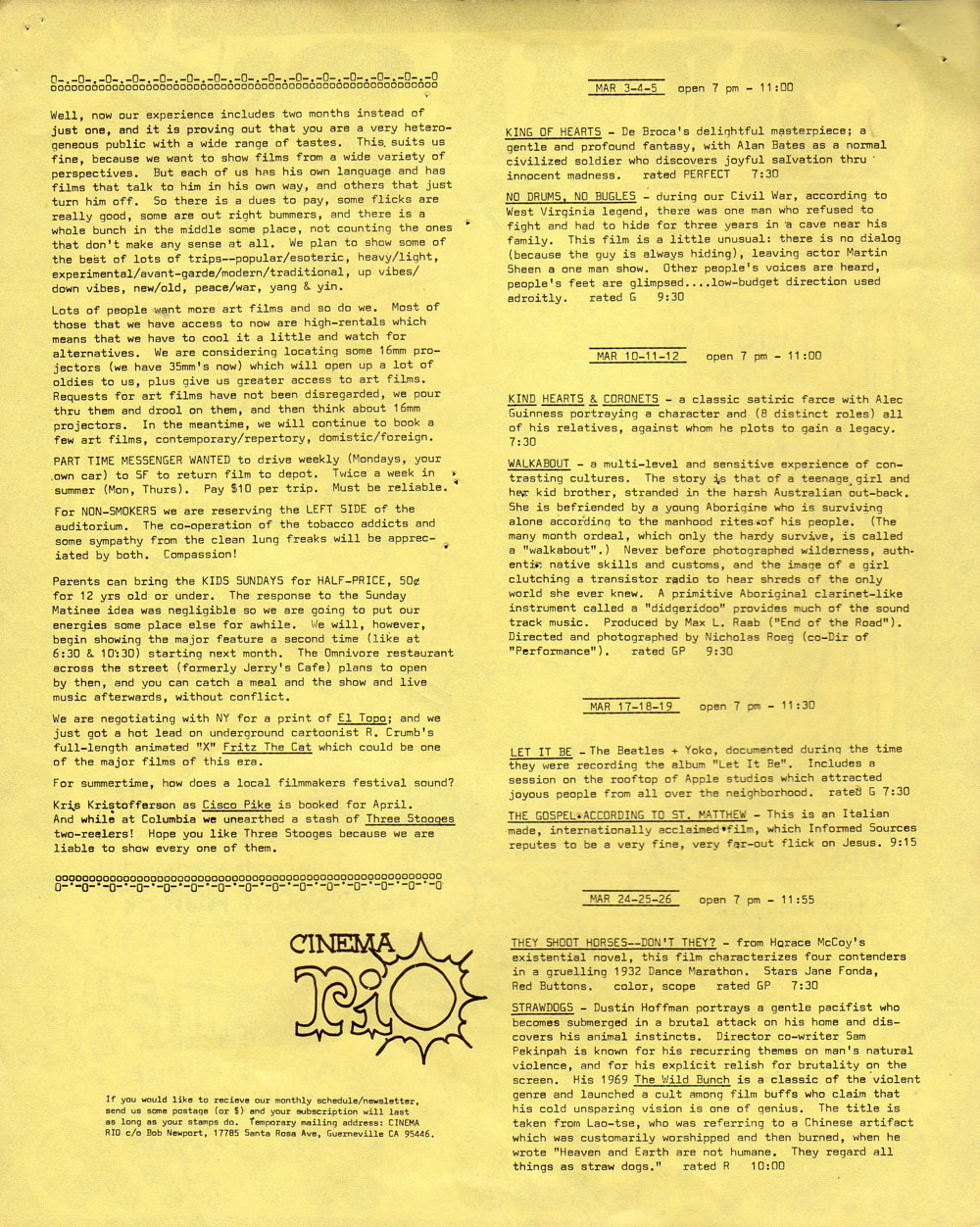
Eventually, Greg and Bob decided to expand their vision. As it so happened, right next to Cinema Rio was a huge old abandoned redwood dance hall, which one day came up for sale, so Greg and Bob decided they would start a community center there. After acquiring the building, they put in a restaurant, a health clinic, ran a community newspaper, and had weekend gatherings where they fed the homeless, including concerts on the beach.
While all of this was going on, Newport was somehow able to operate a psychiatry practice out of his house in nearby Guerneville, often getting paid for his services in baskets of garden vegetables or apples. Bob’s “office” was in a tree house on his property, located in the center of a circle of redwoods. The entire property consisted of an acre-and-a-half, with several cabins scattered throughout the redwoods. It was a diverse operation, including a school in his garage, which twenty-or-so kids attended. Dr. Bob was also heavily involved with the Psych Department at nearby Sonoma State, as on his property various group sessions were ran, such as encounter groups and primal therapy groups.
Cinema Rio and the Monte Rio Community Center eventually folded in the spring of 1973 due mainly to the fact that Newport and Hill got over extended financially. But there were other factors, as well, which caused the scene to run its course, namely the dissolution of Greg’s marriage to Jeanetta. As Newport recalled:
It would have been a miracle if the marriage had survived. Life at the River was incredibly difficult. I mean it was wild, it was high and it was fun, it was creative… and there was no money. Which meant that just trying to scrimp by with a living was hard to do, and it was hard for everybody. It was hard for me, too. I mean I had a little income because I had a little practice going. But the theater made no money—that cost us money. All these other activities we had going—none of them made money… So things were incredibly stressful. And when the marriage broke up, Greg became very depressed. And basically about that time, my mentor who lived next door to me, who had been a very interesting old man, who had dropped out as a President of Union Bank, and had come to the River, and had a very interesting Libertarian philosophy… ah, anyhow, he died, Jeanetta left, and pretty much everything collapsed. And Greg became incredibly depressed. And he went off to New York… and got a job with a bank doing clerical work, which is about as bleak an outcome as you can imagine. So he drank and that became his way of dealing with things.
Rather than end this post on a bummer note, let’s get back to Bob Newport and where his path has taken him over the years, with a brief bio lifted from his website.
Art, and the study of painting, as a vehicle for probing into the relationship between the natural world and the human psyche, is Dr. Robert Newport’s second career following thirty-one years as a psychiatrist. Thirty-one years, during which he developed and refined his powers of observation while delving deeply into the nature of consciousness, exploring its relationship to body, mind and spirit. And when not engrossed in his practice, he was exploring and observing the natural world both as a backpacker and sailor.
Doctor Robert comes from a family of sailors and explorers who arrived with the first settlers in this country in 1607. He was born in the Midwest mid-century, and has never been in the middle of anything since, with the exception of the profound beauty and drama of the landscape. A maverick in everything he has ever done, (he was said to have invented the term “holistic psychiatry”), he came to painting naturally, if not exactly willingly. Drama was his first love; he turned down an offer for the professional theater to go to medical school. With one successful children’s play to his credit, his reading of his muse’s call was to write for the stage; drawing his material from the human dramas he attended as a psychiatrist.
As fate would have it, it fell to him to care for his ailing mother, a successful artist herself for 40 years. In an effort to find a way to have a meaningful relationship with her, he began to paint under her tutelage and later at the Otis College of Art and Design. He found not only that he loved painting, but that it gave him both the vehicle for communicating his experiences of encountering spirit in the natural world as well as the opportunity to continue to use his powers of observation in the further development of his craft. So as a painter and world traveler, he followed in his family footsteps, his sister and niece also being fine artists of some repute. Following his retirement from medicine, he obtained an Otis certificate in fine arts and has continued his studies with private teachers.
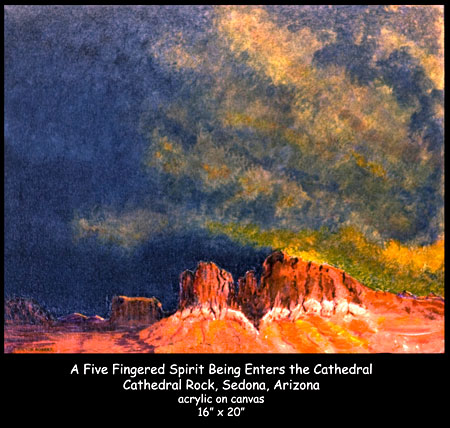
On another note, I just discovered Newport recently released From Haiti to Guinee’ on the Immamou — A Tale of Redemption. Get yourself a copy of enlightenment.
Lastly, we share with you Newport’s take on our latest book, Historia Discordia: The Origins of the Discordian Society:
Whether or not reading Historia Discordia will “blow your mind” or simply show you what a bunch of already blown minds can come up with, is besides the point. The point is that it is fun!
And now, back to our regular programming… whatever that is.
Enjoy!
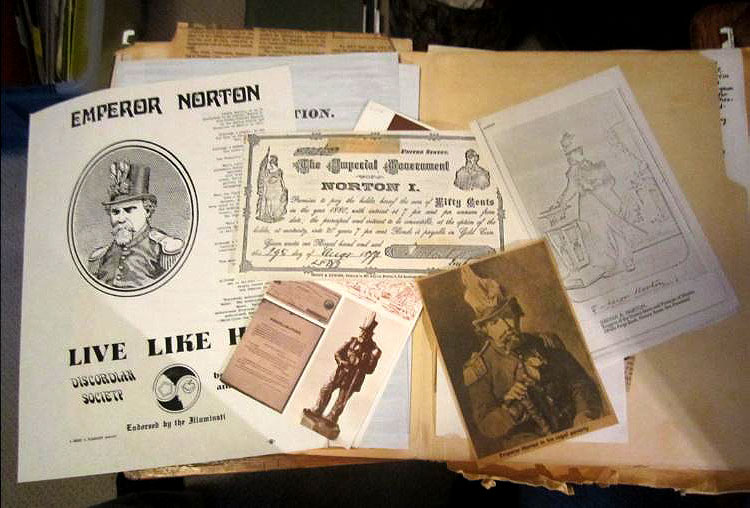
Courtesy of the Discordian Archives.
One of the Saints of Discordia (and saints do not have to be dead, agreed upon or even have a factual existence) is a historical figure by the name of Emperor Norton.
I set off on a mission to visit Norton’s grave, while I was in San Francisco. It turned out I wasn’t the only one who would do so with some frequency. After I walked all the way up, to the top of the steep hill of the graveyard, I gave up on finding Norton’s grave by myself and walked back down to the reception space to ask for help.
“I’m looking to visit a particular grave,” I said. “They’re a well known figure, known as Emperor Norton.”
The lady behind the desk knew immediately who I was after, and produced a photocopied map out from behind the desk.
“We get a lot of people coming to see the Emperor,” she said.
Emperor Norton was born in 1819 in England, but was taken very young to South Africa from where he emigrated to San Francisco in 1849. He made his money as a business person for sometime, until he lost his fortune in a bad investment in Peruvian rice. Norton claimed the supplier had misled him and appealed to the courts to help him out. While early rulings were in his favor, the Supreme Court of California ruled against him. He left San Francisco after this poor fortune, but returned again years later. When he did, he was to become a local legend.
On Norton’s return he no longer took the name of Joshua, and now claimed to be of royal lineage. In a conversation with his friend Nathan Peiser, he explained that he believed himself to be French royalty, sent to England as a child for his own safety, as indeed many children of French Royalty had done during the French revolution, as a response to the generally negative health implications of combining guillotines with angry mobs. Norton realized he had been given the Jewish name Joshua from his adoptive parents as a way to protect him from assassins.
Upon his return, he demanded the dissolution of the United States Government and declared himself Emperor of the United States of America, through the following notice, published by the San Francisco Bulletin in 1859;
At the peremptory request and desire of a large majority of the citizens of these United States, I, Joshua Norton, formerly of Algoa Bay, Cape of Good Hope, and now for the last 9 years and 10 months past of S. F., Cal., declare and proclaim myself Emperor of these U. S.; and in virtue of the authority thereby in me vested, do hereby order and direct the representatives of the different States of the Union to assemble in Musical Hall, of this city, on the 1st day of Feb. next, then and there to make such alterations in the existing laws of the Union as may ameliorate the evils under which the country is laboring, and thereby cause confidence to exist, both at home and abroad, in our stability and integrity.
—NORTON I, Emperor of the United States.
Norton, in many other cities, would have been a curiosity quickly forgotten, but San Francisco embraced him wholeheartedly. It had after all, become a tourist destination in recent history, and Norton had proved himself a character worth writing home about. Tourists were good for Norton personally, as well as San Francisco, providing a market for his Imperial Treasury Bond Certificates (to be repayed, apparently, at 7% interest in the year 1880).
As an additional title, for a little under a decade, Norton also took on the title of Protector of Mexico. He eventually gave up the title, stating “It is impossible to protect such an unsettled nation.”
While certainly destitute and possibly mentally ill, the city of San Francisco celebrated Norton so that he was never plunged too desperately into despair. While some tales of Norton seem suggest that his eccentricity allowed him to effectively live the regal life of an emperor, this seems to be quite the exaggeration. William Drury’s biography Norton I, Emperor of the United States seems to be the main source of most information available anywhere on Norton’s life, painting a somewhat less rosy picture of Norton’s economically challenged existence. However, some companies would set aside tables or seats for Norton’s use and deliver him meals in specially reserved plates and accept his self-issued currency, generally given out in 50 cent denominations.
Norton would be dressed in a blue uniform, with gold-plated epaulets provided by army officers and a beaver hat further decorated with a peacock feather and rosette. There are accounts that say he was known to inspect the condition of public property and the dress standards of police officers, to give philosophical expositions, to attend plays in seats reserved for him, and to eat for free in establishments that valued his presence for the publicity, sometimes with brass plaques under the entrance declaring “by Appointment to his Imperial Majesty, Emperor Norton I of the United States.”
The Encyclopedia of San Francisco suggests he spent 50 cents-a-night (not self-issued currency) for accommodation. He would walk to the Empire Hostel to read his paper, then spend the day on a park bench with friends including the Chinese man Ah How. Norton would decry the unequal treatment of the Chinese in San Francisco.
One story suggests that Norton once stood between a violent mob and Chinese workers during an anti-Chinese riot, protecting the Chinese workers by repeating the Lord’s Prayer until the rioters dispersed.
Norton was said to be good at chess and a great reader who spent much time in these activities at the libraries of various San Francisco clubs. He also used their stationary for the purpose of writing some of his proclamations. He attended church on Sundays, alternating the church he visited. On Saturdays, he attended a Jewish temple. Of this, Norton said, “I think it is my duty to encourage religion and morality by showing myself at church and to avoid jealousy I attend them all in turn.”
William Drury said of Norton, “He carried a dignified and regal air about him, but was seen as a kind, affable man, inclined to be jocular in conversation. He spoke rationally and intelligently about any subject, except about himself or his empire.”
It is suggested, by Samuel Dickinson in Tales of San Francisco, that Norton would be accompanied at plays by two other San Francisco celebrities, a pair of mongrel dogs named Bummer and Lazarus, who were by some accounts, pets of Norton. Stray dogs were, by law, destroyed, but these two had been adopted by the Board of Supervisors, as a reward for their duties in killing the rats that overran the city. Both dogs were well known in San Francisco, and SF resident Mark Twain provided a eulogy for Lazarus when he died. Twain also knew Norton, and based the character of “the King” who appeared in The Adventures of Huck Finn on him. Of Norton he said; “O dear, it was always a painful thing for me to see the Emperor begging, for although nobody else believed he was an emperor, he believed it.”
In 1867 Norton was arrested and placed in a mental institution, though outrage from the public ensured his release. He offered an Imperial Pardon to the policeman responsible, and thereafter was saluted by the police as he passed.
Norton was occasionally the victim of practical jokes in this mode. He was occasionally sent telegrams that alleged to be from other political figures of the time, or he would discover that some other bright spark had been issuing proclamations in his name. As far as can be known, he seems to have suffered these indignities with good grace, with the exception of a broken window in the case of a particularly insulting cartoon. Certain falsified telegrams, perhaps a prank on the emperor, were found amongst his possessions upon his death, along with very small amounts of money.
Norton died in 1880, succumbing to a sanguineous apoplexy. His funeral was large, by some accounts having 30,000 attendees. He was buried in a rosewood casket, provided by a business men’s association, the Pacific Club, at the Masonic Cemetery and at the expense of the city of San Francisco.
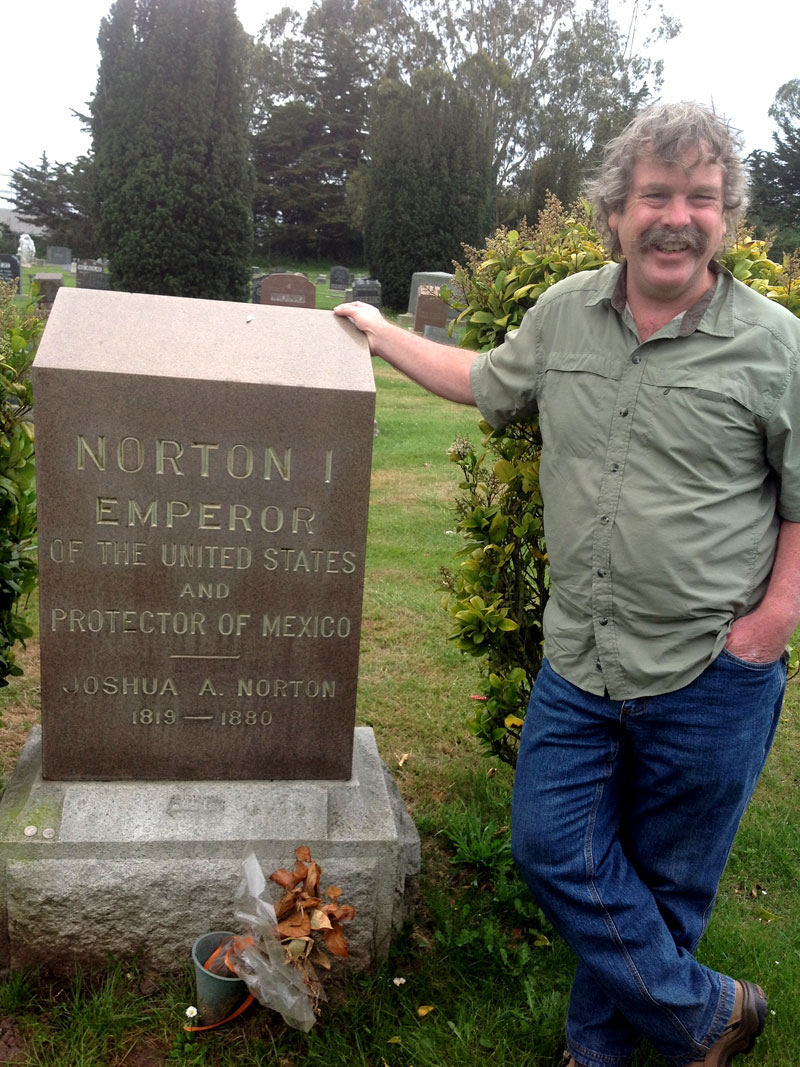
to Emperor Norton's gravesite.
Courtesy of the Discordian Archives.
I spent a little time at Norton’s grave site. In a funny way I felt thankful to him for his example, for the audacity of his madness, and the way in which he gave an example of creating a new reality through consensus, by inviting others to play along. I left some coins, as others had, at the base of his tombstone, and a Pope Card too.
The group E Clampus Vitus hold a party yearly at Norton’s grave. Other groups, such as one assembly of KallistiCon as mentioned in the Portland chapter, as well as individual Discordians, hold events or pilgrimages to Norton’s grave.
Norton’s laws and directives included the following;
1859: Congress is to be abolished.
1859: Gov. Wise of Virginia is dismissed from office, for the hanging of John Brown.
1860: Congress, having refused Norton’s imperial decree is to be forcefully disbanded by the United States Military.
1861: A new theater, Tucker’s Hall, opened with a performance of “Norton the First,” or “An Emperor for a Day.”
1862: The Roman Catholic and Protestant church need both publicly recognize Norton as Emperor.
1869: The Republican and Democratic parties of America are both abolished.
1869: Sacramento is required to clean its muddy streets and install gaslights.
1872: A $25 fine is issued to any person who refers to San Francisco as ‘Frisco.
1872: A suspension bridge is to be built between Oakland and San Francisco. (This one was eventually obeyed long after Norton’s death)
Norton influenced the works of writers such as Twain, Neil Gaiman and Robert Lewis Stevenson. He is also heavily represented in Discordianism.
Norton is listed in the Principia Discordia as an example of a second class saint—being Saints who, by their existence, are ineligible for higher levels of Sainthood, which are reserved for nonexistent saints.
Page 14 of the Principia is taken up entirely by an altered image of Norton’s money.
One manifestation of the Discordians Society in San Francisco was titled The Joshua Norton Cabal. Their slogan was: Everybody understands Mickey Mouse. Few understand Hermann Hesse. Only a handful understood Albert Einstein. And nobody understood Emperor Norton.
This cabal was fictionalized in Robert Anton Wilson and Robert Shae’s classic Discordian work Illuminatus! as a renegade gang poised to resist the Illuminati. Character Doc Iggy gives the following explanation of the cabal
Well, chew on this for a while, friend: there were two very sane and rational anarchists who lived about the same time as Emperor Norton across the country in Massachusetts: William Green and Lysander Spooner. They also realized the value of having competing currencies instead of one uniform State currency, and they tried logical arguments, empirical demonstrations and legal suits ‘to get this idea accepted’. They accomplished nothing. The government broke its own laws to find ways to suppress Green’s Mutual Bank and Spooner’s People’s Bank. That’s because they were obviously sane, and their currency did pose a real threat to the monopoly of the Illuminati. But Emperor Norton was so crazy that people humored him and his currency was allowed to circulate. Think about it.
In the introduction to the purple cover edition by IllumiNet Press of the Principia Discordia, Kerry Thornley has the following to say on Norton:
We asked Goddess if She, like God, had an Only Begotten Son. She assured us that She did and gave His name as Emperor Norton I—whom we assumed was probably some Byzantine ruler of Constantinople. Diligent research eventually turned up the historical Norton, as we call Him, in the holy city of San Francisco—where He walked His faithful dog along Market Street scarcely more than a century ago….
He ended by saying:
Perhaps occasionally the soul of Emperor Norton descends once more into the world to momentarily inhabit the body of an otherwise undistinguished infidel. One day I was sitting in a hamburger stand in rundown Midtown Atlanta. A burned-out speed freak at a nearby table looked at me with a pleasant smile and said, “I’m King of the Universe. I don’t know what I’m doing in a place like this.”
And perhaps that’s the big attraction of our faith. If you want, you can be King of the Universe. Jesse Sump is Ancient Abbreviated Calif. of California. I am Bull Goose of Limbo and President of the Fair-Play-for-Switzerland Committee. Camden Benares is Pretender to the Throne of Lesbos. Greg Hill is Polyfather of Virginity-in-Gold. Sabal Etonia is High Constable of Constantinople. You can declare yourself Archbishop of Abyssinia or Curator of the Moon—we don’t care, but your mailman will be impressed.
The final version of this article will appear in my forthcoming book Chasing Eris.